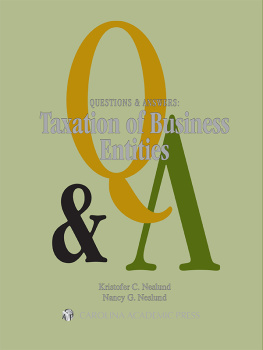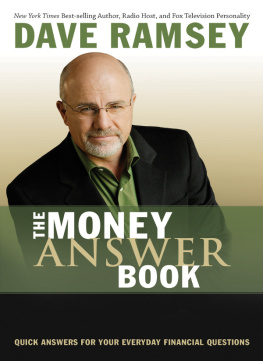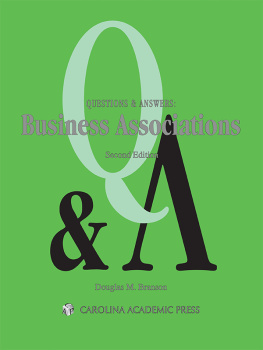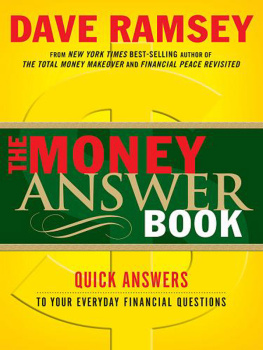QUESTIONS & ANSWERS:
Taxation of Business Entities
[i/ii]
QUESTIONS & ANSWERS:
Taxation of Business Entities
Multiple-Choice and Short-Answer Questions and
Answers
KRISTOFER C. NESLUND
Associate Professor
Golden Gate University
NANCY G. NESLUND
Visiting Professor of Law
University of New Hampshire
School of Law

[ii/iii]
Copyright 2011
Carolina Academic Press, LLC
All Rights Reserved
ISBN: 978-1-4224-8034-2 (Print)
ISBN: 978-0-3271-7044-0 (eBook)
Carolina Academic Press, LLC
700 Kent Street
Durham, NC 27701
Telephone (919) 489-7486
Fax (919) 493-5668
www.caplaw.com
Printed in the United States of America
TERMS OF USE
Your use of this electronic publication (eBook) is subject to the following terms and conditions. This eBook is for your personal use only. All access to and use of this eBook is subject to U.S. and international copyright law. All intellectual property rights are reserved to the copyright holder. Redistribution or duplication of this eBook to any other electronic media or a third party is strictly prohibited unless the original eBook is deleted, purged or otherwise destroyed in its entirety. Under no circumstances may you redistribute this eBook commercially or post this eBook on an intranet, internet or SharePoint site. Any transfer of this eBook shall be to an individual person only and will subject the transferee to these terms and conditions. Finally, use of this eBook is further subject to the terms and conditions of use which were accepted at the time you completed your purchase of this eBook from the Bookstore.
Hyperlink Key
In order to distinguish between the links to other sections within LexisNexis eBooks and external links to the Internet, we have added color coding to the links.
Following is a color key for the links:
Blue: Links inside the eBook
Green: External links to LexisNexis on-line and the Internet
[iii/iv]
TABLE OF CONTENTS
[1/2]
[3/4]
QUESTIONS
TOPIC 1:
SHAREHOLDER-RELATED ISSUES
Unless expressly stated otherwise, throughout this volume it should be assumed that all corporations are Subchapter C corporations, all business entities are domestic, and all individuals are U.S. citizens or residents.
Subchapter C corporations may be referred to as C corporations; Subchapter S corporations may be referred to as S corporations. Limited liability companies may be referred to as LLCs.
Unless otherwise indicated, all authorities using a format such as 1001(a) are references to the Internal Revenue Code, which may be referred to as the Code. Similarly, all authorities using a format such as 1.1001-1(a) are references to the Treasury Regulations, which may be referred to as the Regulations. The Internal Revenue Service may be referred to as the IRS.
Although the focus of this volume is on business entities, it is important to understand certain tax consequences encountered by equity holders in their relationships with their entities. Among the issues are related-party losses, the characterization of recognized gains on sales or exchanges between related parties, losses on worthless stock, and losses on 1244 stock.
1. Lori Rebel owns 70% (by vote and value) of the Corporation. She owns raw land purchased six years ago which Corporation buys at its fair market value to use as a warehouse site. Loris basis in the land at the time of sale is $1,300,000 and its value at that time is $1,000,000.
Three years later Corporation is forced to abandon its warehouse plan and sells the raw land to an independent party for $1,400,000. What are the tax consequences to Lori in the original sale and to Corporation on the later sale?
A. Lori will not recognize any loss and Corporation will recognize a gain of $100,000.
B. Lori will have a recognized loss of $300,000 and Corporation will recognize a gain of $400,000.
C. Lori will not recognize any loss and Madison will recognize a gain of $400,000.
D. Lori will have a realized loss of $300,000 and Corporation will have a realized gain of $400,000.
2. Gwen Boone is the sole shareholder of Marcus, Inc. She also owns an item of depreciable personalty she acquired eight years ago for $250,000. The property has been fully depreciated in one of Gwens sole proprietorship businesses. Gwen sells the property to Marcus for its value, $300,000. Which of the following is correct?
[4/5]
A. Gwen has an ordinary gain of $300,000.
B. Gwen has a 1245 gain of $250,000 and a 1231 gain of $50,000.
C. Gwen has a 1231 gain of $300,000.
D. Gwen has a long-term capital gain of $300,000.
3. William Moore owns .01% of the common stock (only class) of publicly traded Shackleford, Inc. He purchased the stock for $500,000 on December 22 of Year 1. On March 5 of Year 2, a major scandal related to public safety drove Shackleford into Chapter 7 liquidation bankruptcy. Assume the stock became worthless on that day. On his tax return for Year 2, which of the following will William report?
A. A $500,000 ordinary loss.
B. No loss because there was no disposition of property.
C. A $500,000 long-term capital loss.
D. A $500,000 short-term capital loss.
4. Elizabeth Anderson, who is single, decided to open a restaurant. She withdrew $200,000 from savings and contributed it to Comanche Restaurants, Inc., a new corporation, in exchange for all of its common stock (only class). The cost of building out and furnishing the restaurant premises was $600,000. Comanche used $100,000 of Elizabeths cash contribution and borrowed the other $500,000. Elizabeth personally guaranteed the loan.
The restaurant failed in its third year by which time the loan was paid down to $400,000. The lender agreed to settle the debt for $225,000 because of Elizabeths poor personal financial condition. Having no resources, Elizabeth asked her married mother, Maria, for help. After consulting with her professional advisors, Maria decided to acquire stock constituting 99% of the corporations value for $225,000. Her advisers had informed her that, under 1244, $100,000 of her $225,000 loss deduction would be ordinary. Maria decided the stock-purchase approach was preferable to just making a $225,000 gift to Elizabeth.
As soon as the debt was settled, Comanche liquidated. Which of the following is false?
A. Elizabeth will have a $50,000 ordinary loss and a $150,000 long-term capital loss.
B. Marie will have a $100,000 ordinary loss and a $125,000 short-term capital loss.
C. All of the stock issued to Elizabeth and Mary satisfied the literal statutory requirements of 1244.
D. Section 1244 applies to both Subchapter C and Subchapter S corporations.
[5/6]
QUESTIONS
TOPIC 2:
DISREGARDING CORPORATION AS AN ENTITY FOR TAX PURPOSES
C corporations are taxable entities, but this does not mean that a corporation is the taxpayer with respect to a given transaction. The corporation may be an agent, and under the law of agency the principal (which may be the controlling shareholder) is the taxpayer with respect to the transaction. It is even possible that, by not engaging in enough business activity, the corporation is entirely disregarded as a taxpayer, in derogation of the basic rule that C corporations are taxable entities. The corporations status as the taxpayer is the issue at hand in this topic.













